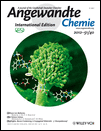Design of a 13C Magnetic Resonance Probe Using a Deuterated Methoxy Group as a Long-Lived Hyperpolarization Unit†
Tomohiro Doura
INAMORI Frontier Research Center, Kyushu University, 744 Motooka, Nishi-ku, Fukuoka (Japan)
Search for more papers by this authorRyunosuke Hata
INAMORI Frontier Research Center, Kyushu University, 744 Motooka, Nishi-ku, Fukuoka (Japan)
Search for more papers by this authorDr. Hiroshi Nonaka
INAMORI Frontier Research Center, Kyushu University, 744 Motooka, Nishi-ku, Fukuoka (Japan)
Search for more papers by this authorProf. Kazuhiro Ichikawa
Innovation Center for Medical Redox Navigation, Kyushu University, 3-1-1, Maidashi, Higashi-ku, Fukuoka (Japan)
Search for more papers by this authorCorresponding Author
Prof. Shinsuke Sando
INAMORI Frontier Research Center, Kyushu University, 744 Motooka, Nishi-ku, Fukuoka (Japan)
INAMORI Frontier Research Center, Kyushu University, 744 Motooka, Nishi-ku, Fukuoka (Japan)Search for more papers by this authorTomohiro Doura
INAMORI Frontier Research Center, Kyushu University, 744 Motooka, Nishi-ku, Fukuoka (Japan)
Search for more papers by this authorRyunosuke Hata
INAMORI Frontier Research Center, Kyushu University, 744 Motooka, Nishi-ku, Fukuoka (Japan)
Search for more papers by this authorDr. Hiroshi Nonaka
INAMORI Frontier Research Center, Kyushu University, 744 Motooka, Nishi-ku, Fukuoka (Japan)
Search for more papers by this authorProf. Kazuhiro Ichikawa
Innovation Center for Medical Redox Navigation, Kyushu University, 3-1-1, Maidashi, Higashi-ku, Fukuoka (Japan)
Search for more papers by this authorCorresponding Author
Prof. Shinsuke Sando
INAMORI Frontier Research Center, Kyushu University, 744 Motooka, Nishi-ku, Fukuoka (Japan)
INAMORI Frontier Research Center, Kyushu University, 744 Motooka, Nishi-ku, Fukuoka (Japan)Search for more papers by this authorThis work was supported by the NEXT Program and partly by Grant-in-Aid number 22685018 from JSPS. We thank Mr. T. Abe of Oxford Instruments for helpful discussion and technical assistance on the DNP experiments.
Graphical Abstract
Supporting Information
Detailed facts of importance to specialist readers are published as ”Supporting Information”. Such documents are peer-reviewed, but not copy-edited or typeset. They are made available as submitted by the authors.
| Filename | Description |
|---|---|
| anie_201202885_sm_miscellaneous_information.pdf682.8 KB | miscellaneous_information |
Please note: The publisher is not responsible for the content or functionality of any supporting information supplied by the authors. Any queries (other than missing content) should be directed to the corresponding author for the article.
References
- 1For a recent review, see for example: E. Terreno, D. D. Castelli, A. Viale, S. Aime, Chem. Rev. 2010, 110, 3019.
- 2For recent reviews on hyperporalized MRI, see for example:
- 2aA. Viale, F. Reineri, D. Santelia, E. Cerutti, S. Ellena, R. Gobetto, S. Aime, Q. J. Nucl. Med. Mol. Imaging 2009, 53, 604;
- 2bA. Viale, S. Aime, Curr. Opin. Chem. Biol. 2010, 14, 90, and references therein.
- 3A. Abragam, M. Goldman, Rep. Prog. Phys. 1978, 41, 395.
- 4J. M. Chambers, P. A. Hill, J. A. Aaron, Z. Han, D. W. Christianson, N. N. Kuzma, I. J. Dmochowski, J. Am. Chem. Soc. 2009, 131, 563.
- 5N. Kotera, N. Tassali, E. Léonce, C. Boutin, P. Berthault, T. Brotin, J.-P. Dutasta, L. Delacour, T. Traoré, D.-A. Buisson, F. Taran, S. Coudert, B. Rousseau, Angew. Chem. 2012, 124, 4176;
10.1002/ange.201109194 Google ScholarAngew. Chem. Int. Ed. 2012, 51, 4100.
- 6A. K. Jindal, M. E. Merritt, E. H. Suh, C. R. Malloy, A. D. Sherry, Z. Kovács, J. Am. Chem. Soc. 2010, 132, 1784.
- 7Y. Jamin, C. Gabellieri, L. Smyth, S. Reynolds, S. P. Robinson, C. J. Springer, M. O. Leach, G. S. Payne, T. R. Eykyn, Magn. Reson. Med. 2009, 62, 1300.
- 8A. P. Chen, R. E. Hurd, Y.-p. Gu, D. M. Wilson, C. H. Cunningham, NMR Biomed. 2011, 24, 514.
- 9T. Nishihara, H. Nonaka, T. Naganuma, K. Ichikawa, S. Sando, Chem. Sci. 2012, 3, 800.
- 10F. A. Gallagher, M. I. Kettunen, S. E. Day, D.-E. Hu, J. H. Ardenkjær-Larsen, R. Zandt, P. R. Jensen, M. Karlsson, K. Golman, M. H. Lerche, K. M. Brindle, Nature 2008, 453, 940.
- 11A. R. Lippert, K. R. Keshari, J. Kurhanewicz, C. J. Chang, J. Am. Chem. Soc. 2011, 133, 3776.
- 12
- 12aS. E. Bohndiek, M. I. Kettunen, D. Hu, B. W. C. Kennedy, J. Boren, F. A. Gallagher, K. M. Brindle, J. Am. Chem. Soc. 2011, 133, 11795;
- 12bK. R. Keshari, J. Kurhanewicz, R. Bok, P. E. Z. Larson, D. B. Vigneron, D. M. Wilson, Proc. Natl. Acad. Sci. USA 2011, 108, 18606.
- 13
- 13aH. Allouche-Arnon, A. Gamliel, C. M. Barzilay, R. Nalbandian, J. M. Gomori, M. Karlsson, M. H. Lerche, R. Katz-Brull, Contrast Media Mol. Imaging 2011, 6, 139;
- 13bH. Allouche-Arnon, M. H. Lerche, M. Karlsson, R. E. Lenkinski, R. Katz-Brull, Contrast Media Mol. Imaging 2011, 6, 499.
- 14Z. Prokopowicz, J. Marcinkiewicz, D. R. Katz, B. M. Chain, Arch. Immunol. Ther. Exp. 2012, 60, 43.
- 15Y. Chen, L. Hu, Med. Res. Rev. 2009, 29, 29.
- 16H.-M. Lee, D. R. Larson, D. S. Lawrence, ACS Chem. Biol. 2009, 4, 409.
- 17A. Razgulin, N. Ma, J. Rao, Chem. Soc. Rev. 2011, 40, 4186.
- 18J. Rautio, H. Kumpulainen, T. Heimbach, R. Oliyai, D. Oh, T. Järvinen, J. Savolainen, Nat. Rev. Drug Discovery 2008, 7, 255.
- 19
- 19aT. Ohe, T. Mashino, M. Hirobe, Arch. Biochem. Biophys. 1994, 310, 402;
- 19bY. Koide, Y. Urano, S. Kenmoku, H. Kojima, T. Nagano, J. Am. Chem. Soc. 2007, 129, 10324;
- 19cT. Doura, Q. An, F. Sugihara, T. Matsuda, S. Sando, Chem. Lett. 2011, 40, 1357.





